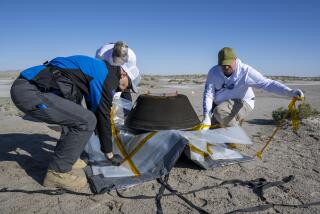Evidence found of ‘impact winter’ after asteroid that killed dinosaurs
Sixty-six million years ago, the massive Chicxulub asteroid slammed into Earth, setting off a chain of events that wiped out the dinosaurs and countless other species.
For decades, scientists have tried to reconstruct the events immediately following the devastating impact to determine exactly why so much life was lost on land and in the oceans. While the impact was tremendous, it wasn’t quite enough to have killed 70% of all life on Earth by itself. What else was responsible for the mass die-off?
Now researchers in the Netherlands say they have found a new piece of the puzzle. In a study published this week in the Proceedings of the National Academy of Sciences, they report the first hard evidence that soon after the asteroid struck, the planet was plunged into a short but devastating “impact winter” that would have darkened the sky, cooled Earth and inhibited photosynthesis.
“There is no question that an asteroid hit our planet 66 million years ago, but so far we haven’t had a lot of hard evidence of the kill mechanisms themselves,” said Sean Gulick, a research scientist at the University of Texas Institute of Geophysics who was not involved in the study. “This research demonstrates that one of those hypothesized kill mechanisms actually occurred — that it got cold. That is pretty important.”
Computer simulations suggest that the Chicxulub impact was just the start of a devastating domino effect. The immediate force of the impact was so great it would have incinerated everything in its vicinity.
But animals and plants living on the other side of the world were not spared. Powerful earthquakes shook the planet in the hours after the impact, creating huge tsunamis. At the same time, red-hot debris from the collision rained down on Earth, igniting wildfires around the globe.
Then the impact winter set in. Dust from the collision and soot from the wildfires rose into the atmosphere, blocking sunlight. Plants had trouble getting enough light to photosynthesize, which led to a wide-scale collapse of the food web. At the same time, temperatures on the surface of the planet began to cool.
And it didn’t end there. Because water holds onto heat longer than land or air, there were significant temperature differences between the atmosphere and the oceans. This gap caused large hurricanes and storms to form, churning up the seas.
The impact winter did not last long, geologically speaking. Over a period that could have lasted from a few months to a few decades, the dust and soot fell out of the atmosphere, allowing sunlight to warm the planet once again.
It’s a compelling story that most scientists have accepted, but proof has been difficult to find — until now.
Using new technologies to measure the temperature of seawater millions of years ago, the Dutch team found that Earth cooled by as much as 7 degrees Celsius — or 12.6 degrees Fahrenheit — after the asteroid struck.
The researchers focused on ancient lipids produced by ocean-dwelling microbes called Thaumarchaeota. These organisms adjust the composition of the lipids in their cell membranes based on the temperature of the seawater around them. When they die, they sink to the seafloor, and the lipids are preserved in sandy ocean sediments.
“Based on the composition of these lipids, we are able to reconstruct the seawater temperature at the time that these sediments were deposited on the seafloor,” said study leader Johan Vellekoop, who is studying for his PhD in earth sciences at Utrecht University.
Finding a place where there were enough of these lipids from the time immediately after the asteroid impact was the scientists’ biggest challenge. They needed a sediment layer thick enough to contain a clear signature from the hypothesized cold spell.
The team looked at sites in Tunisia, Denmark and New Zealand, but none gave a reliable measure of the seawater temperature, Vellekoop said. It wasn’t until they went to the cliffs along the Brazos River in Texas that they finally had some luck.
The Brazos River area is across the Gulf of Mexico from the Chicxulub impact crater on the edge of the Yucatan Peninsula, and it has been well studied by geologists. At the time the asteroid struck, the Brazos River region was covered in a warm sea. After the impact, a huge tsunami washed over the area, leaving a thick coat of sand.
Just on top of that, Vellekoop and his team found an 8-inch layer of sediment that fell through the seawater shortly after the asteroid hit. They knew this because it contained iridium dust, which is found in greater abundance in space rocks than it is on Earth.
The researchers collected samples from this layer and compared the lipid composition at different depths. Nine of the samples indicated a warm tropical sea, but one sample, just above the tsunami sands, was anomalously low.
“There we had the first indication for an impact winter,” said Vellekoop.
Geologists who study the Chicxulub event said they were excited by the new report because it offered a new way to take the temperature of ancient climates.
“That they could apply it to such a short-term event is so impressive,” Gulick said.
Gary Kinsland, a geologist at the University of Louisiana at Lafayette who was not involved in the research, agreed that the new method would help scientists fill in some gaps in their understanding of the cataclysmic event. “This seems like an interesting way to get at some evidence of such cooling,” he said.
In fact, Kinsland said he’d like to see an analysis of sediment from Louisiana, which might contain a signature of the impact winter as well.
Twitter: @DeborahNetburn
Twitter: @DeborahNetburn







